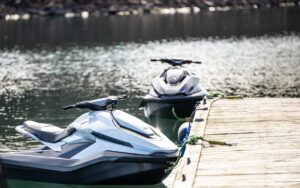Taiga Motors has completed the first stations in a planned 1,100-site backcountry EV charging network, as the Quebec maker of electric snowmobiles and personal watercraft looks to “unlock” 75,000 kilometres of off-road trails and waterways by 2025

Taiga Motors, maker of electric snowmobiles and personal watercraft, seeks to electrify off-road trail networks. Photo: Taiga Motors
Taiga Motors has completed the first stations in a planned 1,100-site backcountry EV charging network, as the Quebec maker of electric snowmobiles and personal watercraft looks to “unlock” 75,000 kilometres of off-road trails and waterways by 2025
Taiga Motors, the Canadian maker of all-electric personal watercraft and snowmobiles, is breaking into the charging infrastructure space with the roll out of its first Level 2 and Level 3 stations at Lake Simcoe, Ont. and Lake Memphremagog, Que.
The charging stations will be powered using “mostly renewable” energy sources, reads the company announcement, with the full plan to include some 1,100 charging stations giving electric off-road riders access to 75,000 kilometres of North American trails and waterways.
According to the announcement, the first stations are on-water installations, while deployment of the first on-land stations will begin in “the near term” in Quebec.

“One of the key strategies of the company is to accelerate the development of our charging network and this is exactly what we’re doing now,” says Jacques Demont, chief commercial officer of marketing and sales in an interview with Electric Autonomy Canada.
“The idea is really to provide our future owners with very interesting routes. We have the support of a lot of locations. There are so many people calling us because they will like to support the expansion of Taiga in North America.”
Taiga’s year of growth
For the last year, Taiga has undertaken an aggressive growth plan ranging from products to infrastructure that’s seen the company increase the size of its order book by 86 per cent.
In April, it completed a merger with Canaccord Genuity Growth II Corp., a special purpose acquisition company (SPAC), that saw Taiga receive $151 million in gross proceeds and become publicly traded on the Toronto Stock Exchange.
Following that announcement, the company moved offices to a new Montreal facility that doubles as a small-scale production plant, an R&D facility and as corporate headquarters. In July, Taiga announced $50 million in government funding for a “mass-production” assembly plant in Shawinigan, Que.
And with the first pilot units now off the production line in Taiga is preparing to make its first deliveries by the end of this year. This month the company announced they have 110 fleet pre-orders for snow and watercraft vehicles.
“We are going in the right direction with the development of the network, the beginning of product delivery soon,” says Demont. “These are very challenging goals, but with the team now I think we have everything we need to be successful.”
A natural evolution
One of the first questions anyone asks about off-road electrification is where do you charge. Given that, it’s not surprising that Taiga says it always anticipated its business would include a charging network.

Now it’s revealed its strategy for doing so. The company plans to operate its own network using in-house software to measure usage and maintenance, has purpose-built an app for riders to access and a dedicated channel on its website that shows charger specs and locations, and it is also building a robust network of partnerships with site hosts.
Some of Taiga’s waterway charging sites will support both summer and winter electric recreational vehicles. Both its watercraft and snowmobiles will take between two to three hours to charge on a Level 2 charger from zero battery, but as very few riders will allow their battery to drain completely, Taiga anticipates the average time spent charging will be around an hour.
For those locations that have a Level 3 charger (supplied by tech giant ABB, which is acting as one of Taiga’s partners) riders are looking at closer to 30 minutes for an 80 per cent charge.
The end goal, it says, is to have a Taiga charging network that spans North America with stations available on all of the major trails and waterways on the continent.
“We will be where there are some nice places — nice marinas — where we will have customers and amenities and the same for the trails all over North America. This will be our priority and step-by-step we will have, in all the good places, a charging solution,” says Demont.












